With galaxies such as the Milky Way strewn with Earthlike planets, the chances of hearing from someone like E.T. -- shown here in a still from the 1982 film -- may not be too bad.
If Here, How Would ETI Communicate?
by Bruce Cornet, Ph.D.
Table of Contents
To date SETI has not confirmed one radio signal from space which could be identified as being sent by a technologically advanced civilization, and radioastronomers have been listening for close to half a century to what they hoped would be frequencies used by ETI (waterhole frequencies of hydrogen and oxygen). The problem might not be an absence of ETI signals, but rather a threshold for verification that excludes virtually all potential hits. A recent close encounter underscores the problem. ARECIBO, Puerto Rico: Signal detected in March 1998. Reported in Home News Tribune on 29 November 1999.
|
With galaxies such as the Milky Way strewn with Earthlike planets, the chances of hearing from someone like E.T. -- shown here in a still from the 1982 film -- may not be too bad. |
Midway through the midnight shift at the world's largest radio telescope, astronomer Jill Tarter picked up what appeared to be a signal coming from a small star named HD119850. There was no mistake. The beacon came in loud and clear at 1535-MHz on the telescope's radio dial.
While English speaking aliens populate TV shows such as Star Trek and Voyager (possible we are told because of a computer-driven universal translator), Contactees and Abductees claim that ET communicates via mental telepathy, and does not need a formal spoken language. Unfortunately, telepathy cannot as yet be qualified or quantified by science, because it cannot be dissected, replicated, and verified. Anecdotal information (information coming from a human) about telepathy is not considered evidence by most scientists. Despite the fact that Cornet has experienced telepathy in association with AOP, he cannot prove that it happened as he perceived it. Dr. John Mack, Harvard psychiatrist, eloquently stated the problem modern science has with anecdotes at a recent PEER forum at the New York Academy of Medicine in NYC.
|
|
|
What Mack said about anecdotes: "I want to say something about the word anecdotal, because we have learned a lot about buzz words doing this work, and anecdotal is one of my favorite buzz words. Now what anecdotal means when you hear it, in this context, is that's what a human being said about what happened to them. In other words, everything that a human being reports about themselves, that's anecdotal. Now by that criterion, of course, everything that happens in a court room, except when you have a physical artifact, is anecdotal. Everything a mother tells a child, that's anecdotal. Every witnessed human experience of the person hearing it who wasn't there is anecdotal. So, anecdotal is a kind of pejorative word that's used to talk about experience that has not (been) met the physical criteria of the physical sciences, the so-called objective criteria."
What Mack said about semantic hierarchy: "Now, there is a hierarchy that is developing around this language, which is kind of interesting. I've looked... Bobbie [Roberta Colasanti] introduced this subject of language. If the person is being pejorative and wants to dismiss it, it's just anecdotal. If there's a little bit of respect, they'll say it's a story. If it has a kind of social-sciency, you know, kind of feel to it, and [the person] wants to credit it a little more, it's called a narrative (laughter in audience). And then if it's like really serious, it becomes a narrative truth. Then you get into shared narratives (more laughter), and so on up the hierarchy. So, a lot of this comes down to language."
![]()
Then again there are reports of aliens who look like us (the "Nordics"), and who speak fluent English. All of the above reports and claims are highly anthropomorphic or Homo-centric, which is another way of saying they are doubtful. But if ET had arrived in our solar system only recently, and was just learning about our species and world, would it attempt to communicate with us before knowing us well enough to predict our reactions and behavior? And once it had studied us sufficiently, and knew our potential and predilection for violence, deceit, and injustice, would it want to communicate?
Many of these questions have been explored before by minds more brilliant than mine. Many more questions than answers have emerged from their discovery. Dr. Allen Tough has devoted much of his professional interest and time to writing papers on the subject. If you are interested in learning about the problems of identifying ET, not to mention communicating with ET, please visit his website called Welcome ETI, its supporters, and about Allen Tough and the invitation to ETI.
Mathematics is considered the universal language, but it can convey only a level of knowledge and/or intelligence. It can be the medium (base code) but not the basis for conversation or the exchange of abstract ideas without a translator. Consider how difficult it would be for anyone to try to communicate exclusively with prime numbers and nothing else.
Computers, for example, communicate mathematically using binary logic circuits which execute Boolean algebraic functions. However, anyone who has studied binary code will quickly appreciate the need for a translator. First level translation (compiling) by a computer produces machine code, which is almost as difficult to understand (some computer programmers can actually read and understand machine code, but it takes much learning and practice). Source codes which use pseudo-language evolved first (JCL, Cobol, etc.), but these codes were too rigid and inflexible in their format. Then came more language-friendly source codes such as 'C', Basic, Pascal, etc. Without a common language for the communication of detailed information and complex ideas, the only way ET could effectively communicate with us is through the use of images, metaphors, facsimiles (including mimicry), and sounds.
During Cornet's six year study of Pine Bush AOP, he used time exposures in order to capture the movements of lights in the night sky. This medium was quickly understood by the AOP that put on performances for his camera. Evidence for this claim comes from the sky glyphs that the lights produced, which were recorded on his time exposures. In many cases it took from one to eight minutes for the AOP to make the pattern in what seemed like slow motion, a process which could only have been captured using time exposures. One recurring sky glyph was the symbol 'S', which will be discussed below. Of all the letters in the English language, the letter 'S' is one of the most intriguing for its multitude of meanings through association.
In addition to sky glyphs, on two occasions the AOP used the night sky for the projection of images which would be easily recognized by humans. These images were recorded on film by Cornet, and are reproduced below. The first was a golden pyramid with a splay of light rising up through it. Pyramid means pyro (fire or light) in the middle. Thus the projected image (however it was done) conveys the meaning of pyramid in shape, color, and syntax. The second image was that of a circular green temple, complete with columns and capstone. The Manta Ray had just flown over Cornet before projecting the image from the left side of the picture. The green splay of light came from the direction and altitude of that AOP. The temple image resembles the Greek temple at Delphi, but it more closely resembles a marble memorial in Houston, Texas (at the Garden of Texas Liberty, where Cornet's second wife Bonnie is buried: See The Passion of Bonnie). This image may have been chosen not for its mythological or archaeological symbolism, but for its familiarity and personal meaning to Cornet.
|
|
|
|
The AOP below produced an 'S'-shaped glyph during the first time exposure, then moved south. As it moved south it began climbing in altitude, until it reached the relative altitude of the brightest star in the eastern sky. It moved towards the position of that star as seen from the ground, and dimmed to extinction as it reached that position.
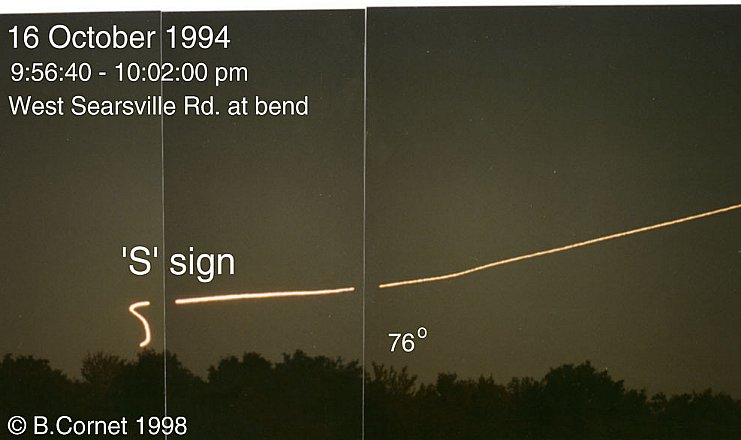
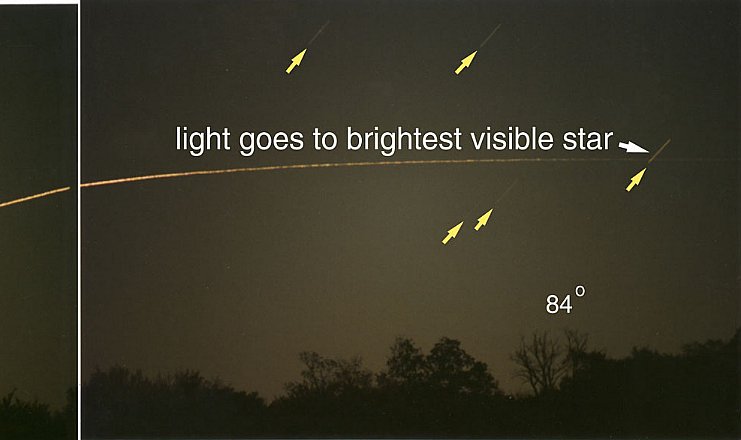
Five star trails are visible in the last image. Any other stars, which would be visible on a clear night, are masked by high clouds or haze near the horizon.
When one takes a look at what stars and constellations were present to the east at that date and time (using Planetarium software by JC Research Inc., obtainable at www.game-club.com/Planetarium), the following is derived for New York City, one hour south of the Wallkill observation center.
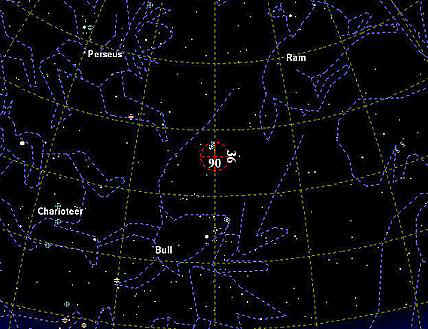
The constellation Taurus (Bull) was positioned due east (90 degrees compass) of NYC.
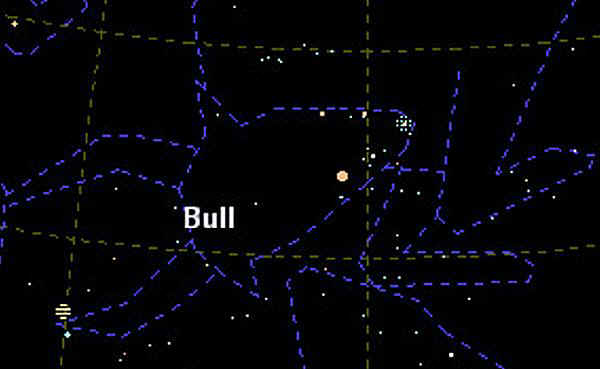
The above images show the constellation at 11:00 pm when it was higher above the horizon, and closer to due east in orientation. At 10:00 pm the constellation was positioned exactly where the stars in the image occur. When that constellation is superimposed upon the time exposure (see overlay below), most of the stars and galaxies fall into place. Going from upper left to right, then down and right to left on the star map, the stars and galaxies which define the head of the Bull are identified as:
Epsilon Tau, Mag 3.6 orange visible |
Delta Tau, Mag 3.9 orange visible |
Mel.25 Hyades (cluster) orange and blue not visible |
unnamed, Mag 4.6 white not visible |
Pi Tau, Mag 4.9 orange not visible |
unnamed, Mag 5.3 blue not visible |
Theta1 Tau, Mag 4.0 yellow not visible |
Theta2 Tau, Mag 3.6 white visible |
unnamed, Mag 4.8 blue visible |
unnamed, Mag 5.5 blue not visible |
Alpha Tau Aldebaran, Mag 1.1 orange not visible |
Alpha Tau Aldebaran with a Magnitude of 1.1 would normally be visible, but because it was very low on the horizon (5 degrees or less), it was blocked by clouds and/or masked by ground illumination. Note that the clouds or haze just above the horizon are brightest exactly where Alpha Tau Aldebaran would be. More than likely that star was responsible for the gradient in light intensity evident in the overlay image. The Hyades cluster was not visible because it too was hidden by clouds and/or was too spread out or diffuse. The star just below Hyades is not visible, because it has a Magnitude of only 4.6.
The star or light tagged by the AOP is not represented on the star chart. Based on its relative brightness, it would have a Magnitude less than 3.0, and perhaps even less than 1.0, given that Alpha Tau Aldebaran does not show up with a Magnitude of 1.1. No planets were in this sector of the sky at that date and time. So what was the AOP pointing to, especially when that light was the brightest light visible in the eastern sky at that time of night?
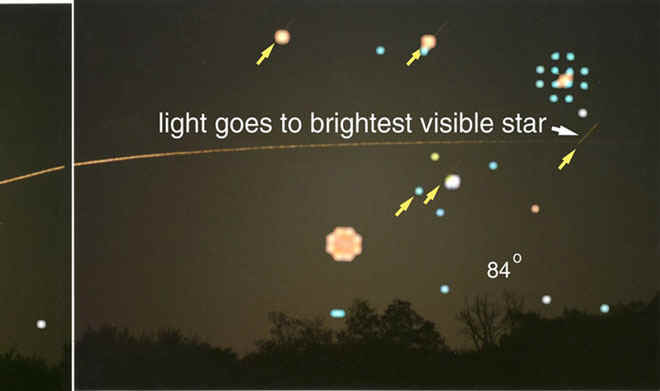
The significance of the AOP pointing out a bright light in the constellation Taurus can be debated. In Greek myth it was this bull (Jupiter in disquise) that carried off Europa. The figure was also known in Egypt as the Apis bull and in Crete as the Cretan Bull. The Bull's face is the Hyades cluster. The Pleiades sit on the Bull's shoulder (at the red cross-hairs on the star map above).
Was it an artificial light? Or could it have been a distant supernova that astronomers missed? Did the AOP come from whatever produced that light? And what about the solar-system-shaped sky glyph produced by a UAP on 29 April 1993; does it resemble the Sirius binary star system?
On six separate occasions an AOP made a sky glyph that resembled the letter 'S'. One in 1992, two in 1993, and three in 1994. In all six examples the AOP performed the sky glyph in the eastern sky, and finished the glyph by travelling south. The first one (September 1992) is poorly done, and took the pilot the longest to make: Eight minutes. The second one (April 1993) was perfect. It was executed by the Manta Ray in one minute and 48 seconds. The third one (below: March 1994) was done by a smaller AOP. It resembles an 'S', but is more like the one done in June 1994. It took six and a half minutes to execute. It almost seems as if competition was going on to see who could make the best 'S'-shaped sky glyph, but that would imply that others were watching or they somehow had access to my photo composites.
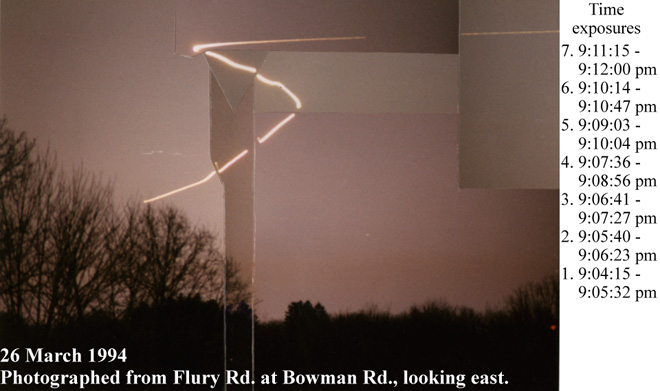
But before I continue comparing 'S'-shaped sky glyphs, the second performance needs to be described in detail. It is spectacular in several respects: Size of craft (large); type of aerobatic stunt performed; time or speed of execution (very slow); demonstration of exotic technology (atmospheric ionization); signaling with lights; and a major associated magnetic anomaly, which was opposite and inverted from normal. Three people witnessed this performance: Bruce Cornet, his current wife Pat Huff-Cornet, and her son Niles Leisti.
The 8 April 1993 event began with Cornet spotting a pair of reddish-yellow lights to the east. The sky was heavily overcast, limiting visibility to only a few miles. The time was 11:07:40 pm by his watch. The lights were very low to the horizon, which has been one of the first distinguishing characteristics of a Pine Bush AOP about to put on a performance. He could be certain that he was not just seeing a conventional aircraft at great distance, because of poor visibility. For reference see composite graph of images below.
Cornet began his first time exposure, but the lights dimmed and went out after only 23 seconds. He closed the camera shutter and took a compass reading for the direction of the shot. Almost a minute passed without anything happening. Then at 11:08:55 pm the lights came back on again, but this time slightly further south. They were still unusually low to the horizon. His second time exposure lasted only 21 seconds before the lights dimmed and went out again (photo #2 in composite graphs). Cornet took another compass reading for the direction of the shot. Forty four seconds passed until the lights came back on for a third time, but this time they were closer to the camera. Photo #3 was long enough a time exposure (54 seconds) to capture the tree line just below the lights, which would give him a compass reference point. Each time the lights came on, they were a little further to the south.
Almost four minutes passed before the lights came on again. When they did, they were much closer to the camera. Now he could be certain that the AOP was only a few tens of feet above the tree tops (see composite graph below). Whereas the compass angle between the first and second shot was seven degrees, the compass angle between the second and third shots decreased to two degrees as the AOP moved closer. However, the compass angle between the third and fourth shots jumped to 15 degrees (7 - 2 - 15). Now the AOP was less than a half mile away, and its lights could be seen clearly. In addition to a pair of bright headlights, it had red and green outboard running lights, a pattern common to many commercial jetliners, but also charactersitic of the Manta Ray. Estimated distance traveled in five minutes: Three miles MAX! That computes to an average speed of only 36 mph! Although that speed could not be computed until the data were analyzed, it rules out all commercial aircraft, and all but the smallest and slowest of stunt fixed-winged aircraft.
Before I describe the 'S'-shaped aerobatic stunt performed by the Manta Ray, it is important to discuss why compass measurements were taken. Such measurements are an additional source of data for documenting direction, distance from camera, distance traveled, speed, etc. On this particular night Cornet's care in recording azimuth data paid off in Spades. Without those measurements, he would have been unaware that a major magnetic anomaly happened in association with the AOP performance.
Later when he examined the tree line pattern in order to determine precise compass direction, he discovered this anomaly. He had noticed that his compass readings were decreasing in value as the shots progressed from north to south. That should not happen. Compass measurements should increase in that direction, because azimuth starts at true North with a value of zero, and increases in a clockwise fashion to 360 degrees, or a full circle. Due North has a compass value of zero or 360 degrees, while due South has a value of 180 degrees. But without tree line reference points in the time exposures, he could not be certain about the nature of the anomaly.
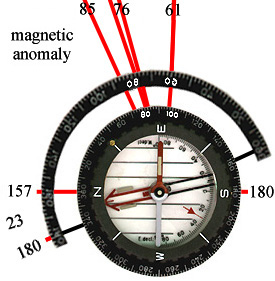
Upon careful examination and the determination of two accurate compass directions based on tree line patterns in photos #3 and #4, Cornet discovered that not only was the magnetic field nearly reversed (23 degrees shy of absolute magnetic reversal), but it was also inverted. In other words, his measurements were off by not only 157 degrees, but East became West and North became South!
The magnetic anomaly associated with an AOP is clearly significant, but what could it mean? Was I being given a blunt facsimile of what could happen in the near future? Are we close to a point in time when the Earth's magnetic poles might flip? Only time will tell.
All the images are displayed below.
|
|
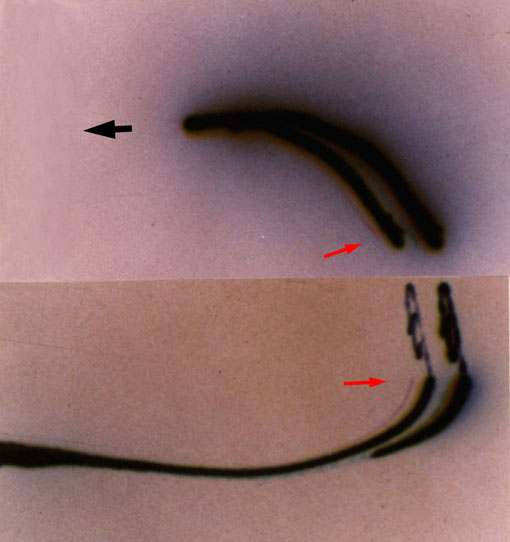
It then rolled over onto its belly as it reversed direction, and flared both its headlights. The intense orange-red glow of ionized air and NO2 gas stand out as a deliberate act (see Plasma Orbs). Note in the above images that the ionization (blue haze) around the main lights began just before the climb, stopped during the climb, and then resumed after the climb. What kind of propulsion/lift engine would do that?
After it made its turn back towards the south at the top of the glyph, the pilot turned out both headlights. He then turned on the left one after a short distance and dimmed it gradually. As the left light dimmed out, the right light was turned on and dimmed gradually in a similar fashion. Was this a signal?
Following this performance, the Manta Ray departed travelling south while accelerating (photo #6). It made a very faint jetlike sound moving through the air (too faint to be recorder above audio noise), and turned on additional lights, which made its pattern of lights resemble that of a conventional jetliner. Listen to the comments Cornet and Huff-Cornet made as the AOP completed its aerobatics (Calling the shots, which ends with Cornet saying "silent"). Then listen to a .wav file of amplified background sound as the AOP departed. All you will hear is undifferentiated noise and faint breathing, with no clear sound of a jet engine.
![]()
Comparisons of 'S'-shaped Sky Glyphs
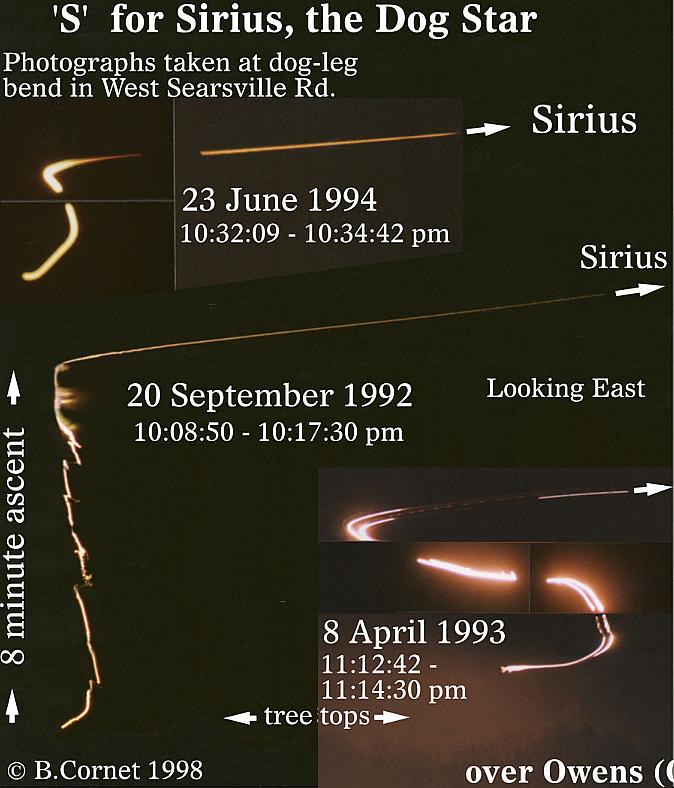
The fourth 'S'-shaped ditto (below: 2 June 1993) was the size of the first one (20 September 1992), but this time the pilot (or intelligence in control) did a perfect pattern, and it took him 3.8 minutes less in which to perform it. Ellen Crystall was present and taking photographs of the same light. Her photograph which shows the light ascending into the cloud has one major difference from the picture Cornet took. Crystall was standing next to Cornet, not more than three feet away from him. In Cornet's picture the light shows a zig-zag motion just before entering the clouds. Crystall's picture does not show this zig-zag pattern. Instead the light goes straight up with no sideways motion. Both pictures showed the overhead clouds reflecting back the same pattern of light, although the back reflection is more intense in Crystall's photo.
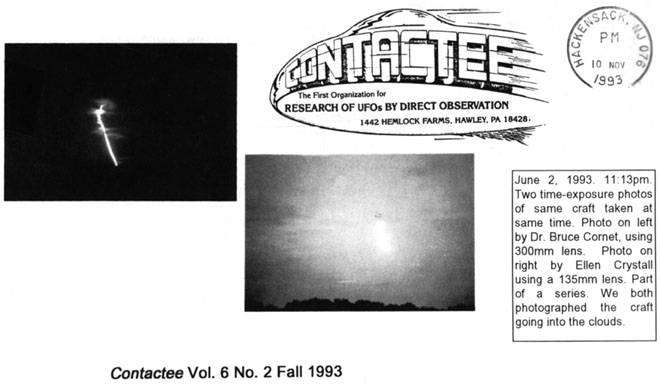
This example is one of two examples where Cornet and Crystall photographed the same AOP, but their photographs showed significant differences. Those differences led Cornet to perform an experiment on 9 May 1994, which is the subject of another web page called The Experiment. The results of that experiment seem to confirm that some AOP can project selected images or views to different individuals on the ground.
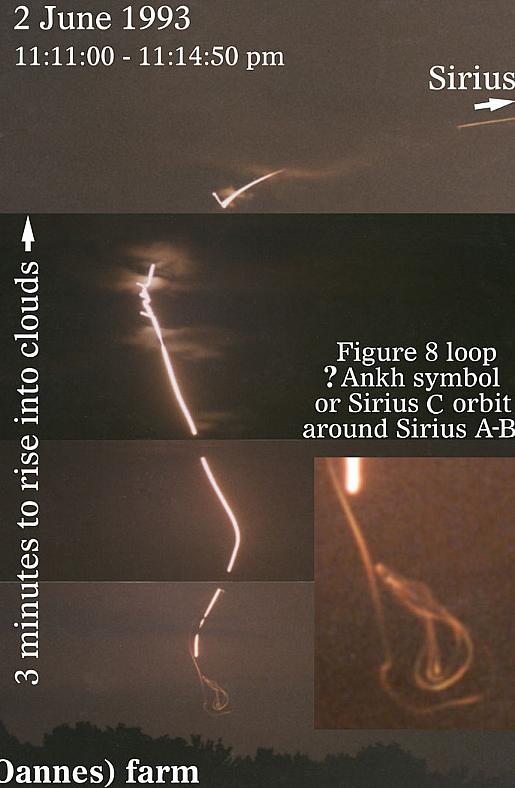
At the bottom of the composite image (above), the first time exposure shows something extraordinary. A brilliant orange-red orb departed from the main light just before Cornet closed the shutter to his camera, rapidly moved downwards and then did a series of loops before the shutter door completely closed. Because the shutter door swings downwards, it cuts off the bottom part of the image first (image inverted by camera lens). That means that the orange-red light traveled all that distance and completed the looping pattern in a fraction of a second before the camera shutter began to close. Humans categorically do not have technology that can do this, period! One scientist who examined these photos suggested that the orange-red light was a rocket booster that had been jettisoned, but no rocket booster would have continued to fly back upwards, doing a repeated looping pattern - all in a fraction of a second. Contrary to the rocket booster explanation, this AOP performance was done in complete silence.
|
|
Note that as the AOP main light rises through a low bank of fog or mist, the light was either dimmed intentionally, or it was occluded by the fog. The moisture in the air might have actually extinguished the plasma by dampening the ionization process via cooling the hot gases.
In June 1994 an AOP made another 'S'-shaped ditto before disappearing to the south. But it was not until October 1994 that an AOP actually tagged the brightest star (light) in the eastern sky. Normally that star would be Sirius in the constellation Canis Major.
Ditto: A mark or a symbol for a word or phrase; a word used by stunt pilots for aerobatic formations. Why an 'S'-shaped ditto? An ET probe visiting Earth and studying humankind would quickly encounter repeating symbols used in language. Where images are associated with descriptive text on astronomy, science, religion, and mythology (astrology), ETI would find many recurring 'S' words. All the 'S' words in the English language don't have to be listed here - just enough to make an impression:
See Sight Stare
Signal Sign Sine
Signature Show Sequence
Sound Speech Say
Sixth Sense Synchronism
Synergism Silent Symbol
Symbolic Symmetric Sphere
Spiral Square Signify
Significant Synonymous Search
Seek Solution Skeptic
Stump Subtle Suggest
Speculate Supposition Sufficient
Support Schlep School
Science Start Shift
Season Spring Summer
Sky Soar Space
Shuttle Solar System
South Saturn Syzygy
Satellite Stratosphere Storm
Stereo Stellate Star
Sun Sirius Serious
Sagittarius Scorpio Sumerian
Sanskrit Stage Standard
Savior Save Soul
Saint Sanctuary Sacred
Scripture Synoptic Service
Sacrifice Sheep Summit
Success Sincere Sin
Sadistic Satan Sultry
Sulfur Set Seth (mythological)
Santa Claus Secular Social
Six Six Six Sex Stamen Stem
Sterile Semen Serpent
Snake Scale Sword
Salute Sleuth Steal
Secret Sect Seal
Secure Safe Select
Self Strong Steel
Step Stop Still
Static State Stationary Sit
Site Situation
Summary Seed Seeding 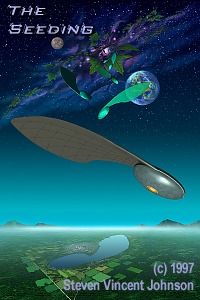
and last but not least
Superman 
who can be found at almost any newsstand where comics are sold (especially during the 1950's and 60's), who came from another world, and who helps humans in benevolent ways. If ETI wanted to give us a message, which it hoped would be received positively, what familiar metaphor could it use? Note how the 'S' shape of the April 1993 ditto closely matches the Superman logo 'S' in shape. Is this just coincidence? Of course, what else could it be? It must also be coincidence that the shape of the Superman logo is nearly identical to the outline shape of the Manta Ray.
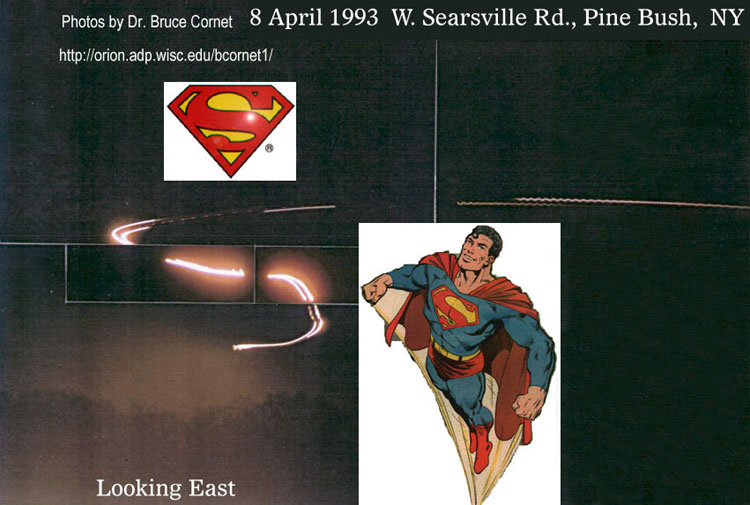
Is this communication via the use of symbols and metaphors? Was this an attempt to give humankind a message? How would you have done it in a non-threatening neutral manner?
I need to ask the question again: If here, how would ETI communicate with us? But to answer that question objectively you must remove any assumptions, beliefs, theories, biases, and prejudices you may have based on years of cultural exposure to Science Fiction, the Media, and Scientific Dogma. Sometimes the answer we seek is staring us in the face, but we cannot see it through the filters our minds place over our eyes.
What comes out of the human mind is only as good as the data that goes into it. As computer geeks say, "Garbage in, garbage out." Reality is a semantic construct of culture and society. Reality is not what IS, but what consensus opinion defines as reality. Anything that does not fit the consensus viewpoint is commonly treated with disbelief, ridicule, and/or denial. However, beliefs (and their counterparts: disbeliefs) are artificial substitutes for what IS, when the truth is not known.
Humankind does a lot of plugging holes in its vast ignorance with assumptions, postulates, theories, and beliefs, because we don't like looking into a bottomless black pit called the void. It makes us feel insecure and uncomfortable when we are not standing in the light and cannot see and/or feel what we are standing on, even if the sensation or reflection of substance is coming from some artifact, illusion, or contrived substitute for the truth. Our whole dualistic Western psychology is geared towards education and logical thinking, with modern science holding the standard, and yet "truth" or "reality" is as dependent on the data which has been selected to "see" it as the output of a computer is dependent on the precision of the code it requires to operate.
So what does this have to do with ETI communication? Everything.
In my humble opinion, humankind has a long way to evolve before our species can collectively recognize, meet, and communicate with any ETI. We must first overcome our fear of the unknown and contempt of that which is different or not like us. Communication is not simply the turning of a dial or flipping of a switch to some piece of technological hardware we built. We will have to meet ETI half way (on both physical and psychological grounds) if we expect ETI to meet us half way. Until then the majority viewpoint will be where-ever the light seems to be shining, and not where what is being sought necessarily resides. ETI, if here visiting Earth, will probably attempt to communicate with us, but according to its own cultural, genetic, and technological predilections (assuming that ETI perceives "reality" from a similar biological standpoint using highly evolved organic sensors for detecting light colors, sounds, vibrations, chemicals in the air, and gravity). If, however, the frequency being used by ETI is not what we are tuned into, ETI could be staring us in the face and the official position will continue to be one of ignorance and/or denial.
Roberta Colasanti, Clinical Director of PEER, stated the problem well at the PEER forum in New York City on 16 November 1999 (Entering the Heart of the Alien Mystery, co-hosted by Dr. John Mack).
She said, "I'm not convinced that if someone landed on the White House lawn tonight that this would provide us with physical evidence this is happening. I think that depending on the mindset we're in and what we determine again based on our own cultural agreement about what's real or not, there'll be lots of explanations as to what it is other than what is happening."
![]()
Has ETI communicated with me? I do not know for certain. Someone or something clearly presented me with a vast amount of anomalous data, which can be interpreted in various ways. I will resist all attempts to substitute - any - "realistic" or "logical" explanation for what I recorded just because it is logical or agrees with the consensus concept of reality. In other words, I am willing to tolerate uncertainty, but will continue to seek the truth with honesty and objectivity.
Copyright © 1999 Sirius Onion Works
Last modified:
August 22, 2022
Background picture: Hubble telescope image from NASA